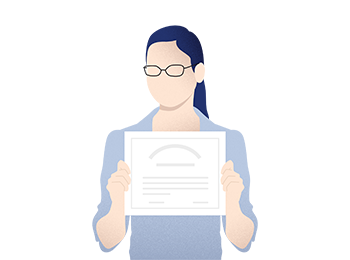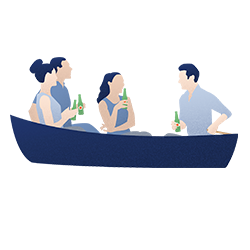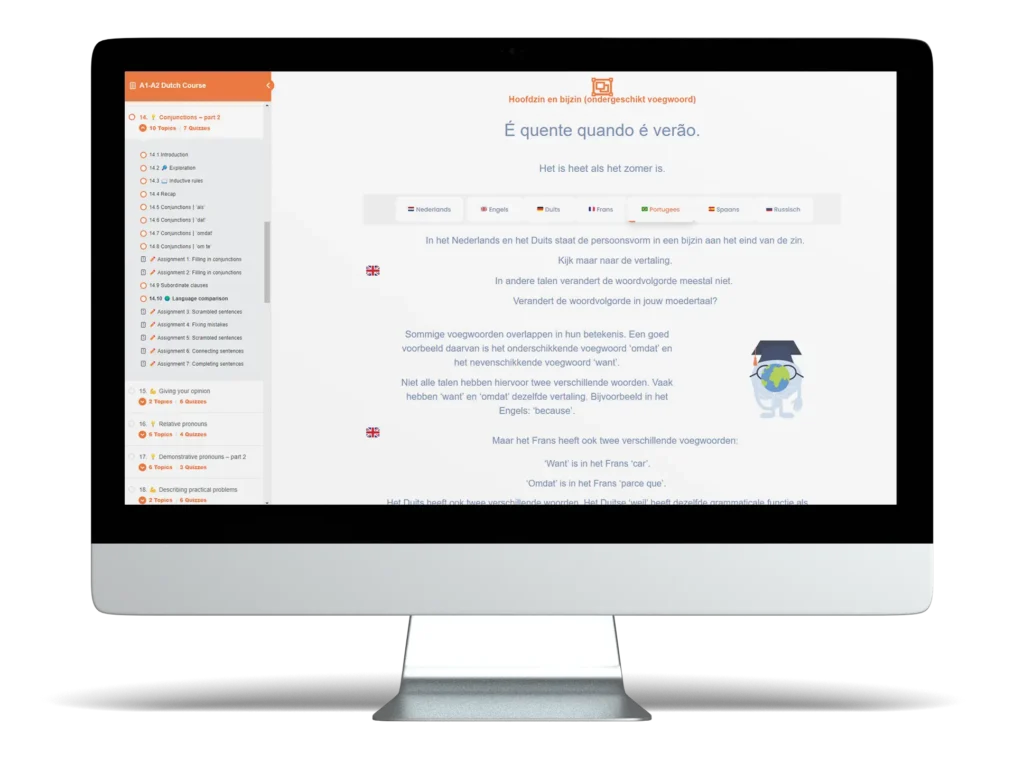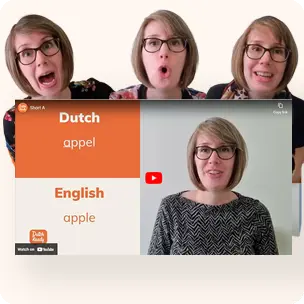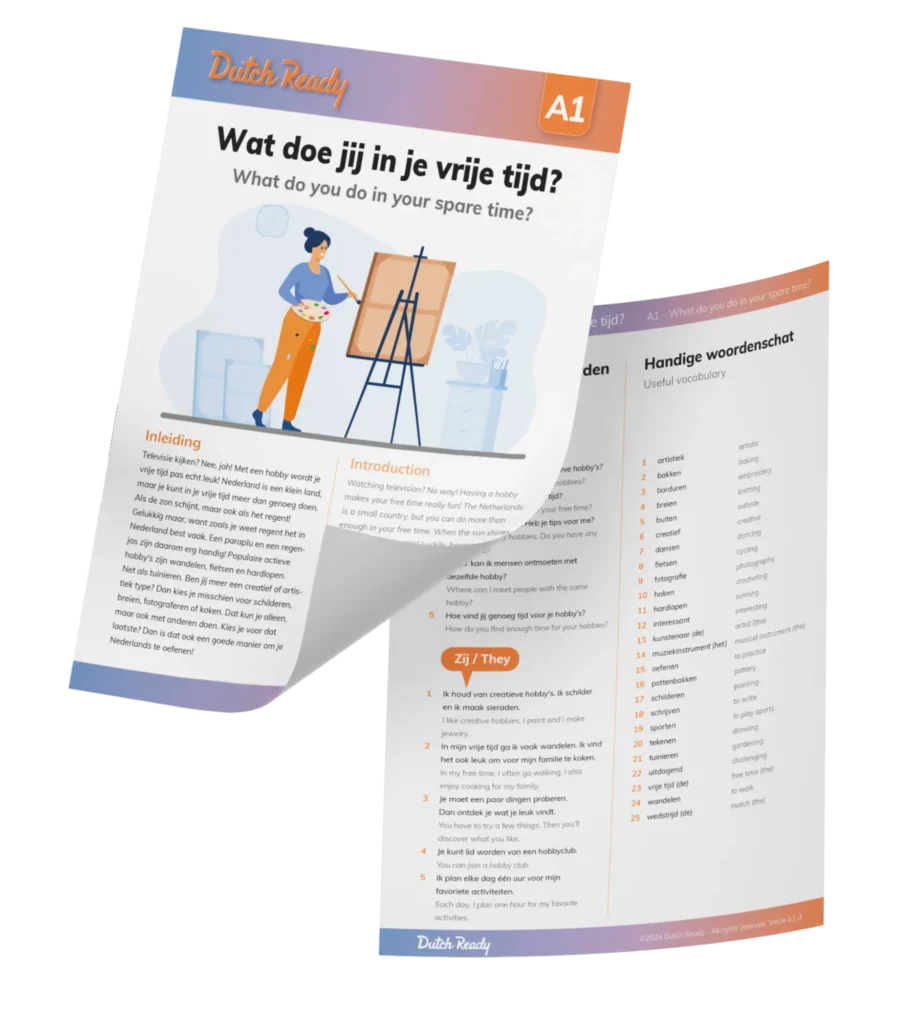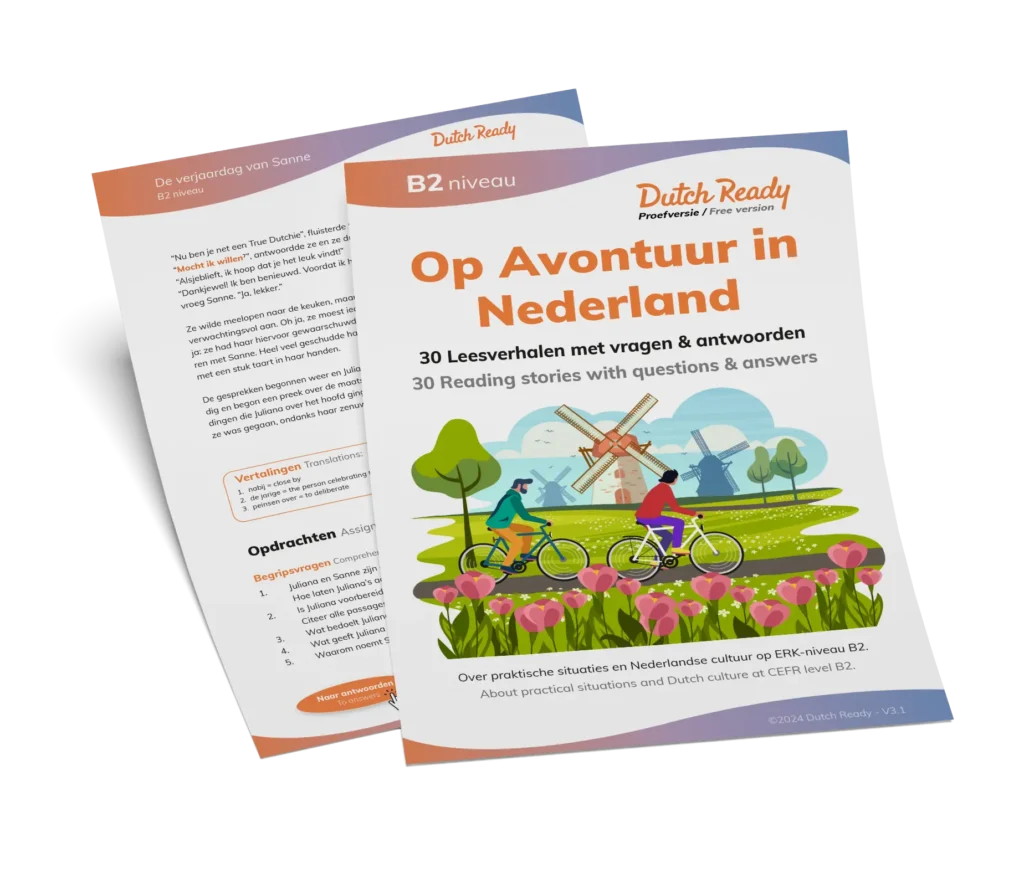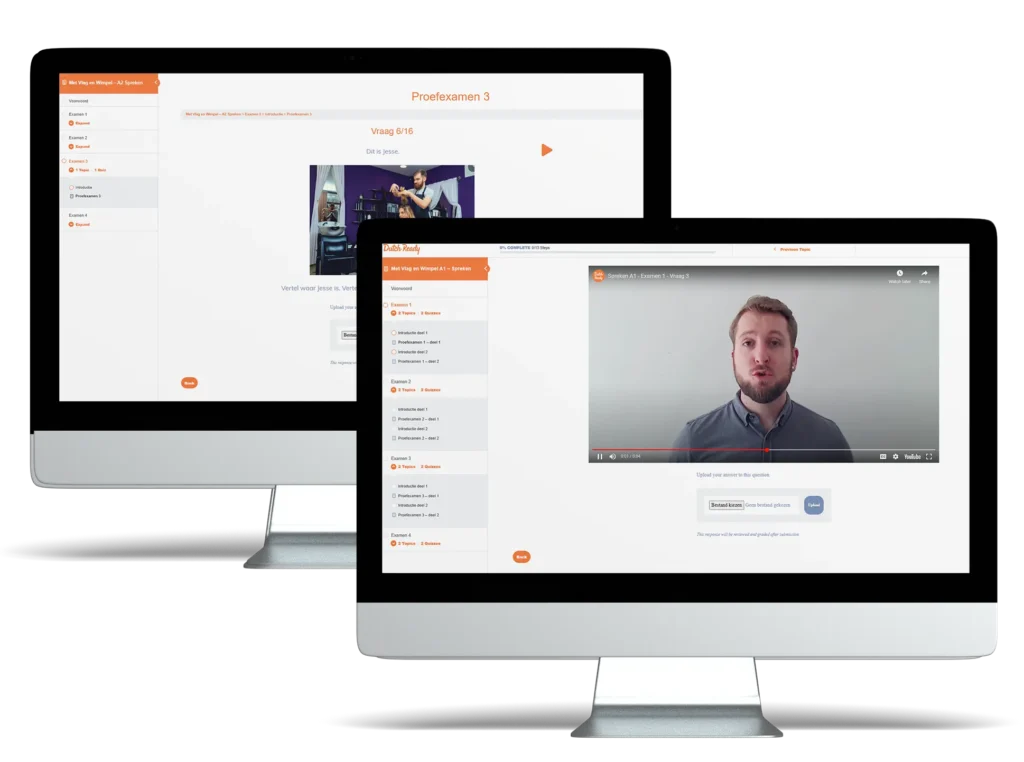

When you’re a complete beginner, Dutch language level A2 is a good level to work towards when you want to chat more easily with coworkers, neighbors and other Dutchies, and fulfill your daily activities and obligations with greater ease. It’s this language level that makes communication in daily life much easier. But what exactly is the Dutch language level A2? Let us tell you more about it.
Even though the A2 level is known as the elementary stage, it plays a crucial role in helping you navigate daily life and integrate into Dutch society. At this level, you can handle basic conversations, whether you’re grocery shopping, using public transportation, or scheduling appointments. Besides, A2 is often essential for jobs in sectors like hospitality and customer service, where basic communication is key.
Moreover, when you decide to learn Dutch at A2 level, you will lay the foundation for future language development. This prepares you to progress to more advanced levels like B1 or B2. In short, Dutch A2 is your gateway to greater independence, job opportunities, and successful integration in the Netherlands. In this blog, we will take a closer look at what it means to reach the A2 language level in Dutch. We will also tell you how it compares to other levels, and how to prepare for exams that assess this proficiency.
Language levels are often measured using the Common European Framework of Reference for Languages (CEFR). This is a widely recognized system for evaluating language skills. The CEFR is a standardized framework that breaks down language proficiency into six levels: A1, A2, B1, B2, C1, and C2. Each level reflects a learner’s ability to use the language in real-life situations. The framework emphasizes four key skills:
The common reference level for A2, according to the CEFR, is stated as followed:
“Can understand sentences and frequently used expressions related to areas of most immediate relevance (e.g. very basic personal and family information, shopping, local geography, employment). Communicates in simple and routine tasks requiring a simple and direct exchange of information on familiar and routine matters. Can describe in simple terms aspects of his/her background, immediate environment and matters in areas of immediate need.”
Want to get to the bottom of it? On their website, you can read the details of the CEFR reference levels for each of the six language levels. However, the EU can often get quite technical. That’s why we’ve made an easy to understand overview of the skills and themes needed for each level, which you can download for free from our website. We’ll tell you more about it in a bit.

Want to learn Dutch A2? The four skills that the CEFR distinguishes might be new to you. Most learners are familiar with the classical division between reading, listening, writing and speaking. By adopting other modes of communication, the CEFR has moved away from these well-known classical skills as the base of describing language proficiency. As you may have noticed though, the four traditional skills are represented within the modes of communication. Reading and writing are covered by Reception, while speaking and writing are covered by Production. Furthermore, Interaction and Mediation are tested in language tests, but they are usually embedded within the traditional skills of reading, listening, speaking, and writing, rather than being assessed as standalone categories.
But let’s go back to the question that you probably like to see answered most: what does it mean to reach the A2 language level in Dutch? In short, when you learn Dutch at level A2, you can understand sentences and frequently used expressions related to areas of immediate relevance. For example, you could think of personal and family information, shopping, surroundings, and employment. Practically, this means that you are able to:
Unlike higher level learners, A2 learners are still developing their fluency, but can already navigate simple social exchanges.
Not sure if you should learn Dutch at A2 level? You’re not the only one. Oftentimes, we get asked what the difference between language level A1 and A2 is exactly, and what the difference is between language level A2 and B1. The main difference between language levels A1 and A2 lies in the range of expressions and tasks a learner can handle. Also, at A2 level, you rely a bit less on slowness of speech and support from your conversation partner. The difference between language levels A2 and B1 is marked by a transition from basic to more independent language use. At B1 level, you are able to express yourself more fluently and to navigate most daily situations at a pace that is reasonable to a native speaker.
To give you a clearer picture of what the Dutch A2 language level entails, the table underneath compares level A2 with A1 and B1 on each of the four classic competences.
Level A1 | Level A2 | Level B1 | |
listening | Can understand basic phrases and instructions. | Can follow slow, clear speech about familiar topics. | Can understand the main points of clear standard speech on familiar topics. |
reading | Can understand simple signs and basic information. | Can read short, simple texts, like advertisements. | Can understand texts about everyday subjects. |
writing | Can write simple phrases and fill out forms. | Can write short messages and notes. | Can write simple connected text on familiar topics. |
speaking | Can introduce themselves and use basic phrases. | Can participate in simple, routine conversations. | Can deal with most situations likely to arise in daily life. |
In order to obtain an official diploma in Dutch language level A2, you are expected to have basic proficiency in listening, speaking, reading and writing in Dutch. Besides, for the Inburgering at A2 level you are also required to pass the KNM portion about Dutch history and culture. Below, we show you some examples of A2 language expressions, again compared to the levels A1 and B1.
Dutch A1 level | Dutch A2 level | Dutch B1 level |
“Ik ga naar de supermarkt en naar de dokter.”
| “Ik ga vandaag naar de supermarkt en daarna moet ik naar de dokter.” (I’m going to the supermarket today and afterwards I need to go to the doctor.) | “Vandaag ga ik eerst boodschappen doen in de supermarkt en daarna heb ik een afspraak bij de dokter.” (Today I’m going to get some groceries at the supermarket first and then I have an appointment at the doctor.) |
“Hoi Anna, ik kan morgen niet komen. Ik moet naar de tandarts.”
(Hi Anna, I can’t come tomorrow. I have to go to the dentist.) | “Hoi Anna, ik kan morgen niet naar de lunch komen. Ik heb een afspraak bij de tandarts. Groetjes, Lisa.”
| “Hey Anna, helaas kan ik morgen niet bij de lunch zijn, want ik heb een tandartsafspraak. We kunnen misschien een andere keer afspreken. Groetjes, Lisa.” (Hi Anna, unfortunately I can’t join lunch tomorrow, because I have a dentist appointment. Maybe we can meet another time. Regards, Lisa.) |
“De supermarkt is open van 08.00 tot 20.00. De supermarkt is in het weekend open van 09.00 tot 18.00.” (The supermarket is open from 08.00 to 20.00. On the weekend, the supermarket is open from 09.00 to 18.00.) | “De supermarkt is van maandag tot vrijdag van 8:00 tot 20:00 geopend. Op zaterdag en zondag is de supermarkt van 9:00 tot 18:00 geopend.” (On Monday to Friday, the supermarket is open from 08.00 to 20.00. On Saturday and Sunday, the supermarket is open from 09.00 to 18.00.) | “De supermarkt is doordeweeks geopend van 08.00 tot 20.00 en in het weekend kan je tussen 09.00 en 18.00 boodschappen doen.”
|
“Ik werk op een kantoor. Ik begin om negen uur. Wat doe jij?” (I work at an office. I start at 09.00. What do you do?) | “Ik werk op een kantoor en ik begin meestal om negen uur. Wat doe jij voor werk?”
| “Ik werk op een kantoor waar ik meestal om negen uur begin. En jij? Wat voor werk doe jij precies, en hoe laat begin jij?” (I work at an office, where I usually start at nine. And you? What kind of work do you do exactly, and what time do you start?) |

Are you preparing for an exam, or do you just want to take the next important step in mastering Dutch? The Dutch Ready language level Roadmap is a tool that helps you track your progress through the Dutch language levels. It shows you a clear overview of the requirements, complete with further explanation and examples. Our roadmap, which you can download for free on our website, covers levels A0-B2 and is completely CEFR aligned. Use it when you learn Dutch A2, as well as for the levels that follow.
There are more than enough reasons to choose to take an A2 exam. Let’s list the ones we hear most.
You:
There are two official exams that test for Dutch language level A2: the first one being the civic integration exam that we mentioned before, and the second one is the INFO-exam from CNaVT.
The civic integration exam is intended for non-EU nationals who wish to live and work in the Netherlands. It is a mandatory requirement for obtaining permanent residency or Dutch citizenship. Since January 1st, 2022, the test level to pass the exam changed from A2 to B1. That doesn’t apply (yet) to expats, for whom the exam is not mandatory. Are you an expat that wants to naturalize or obtain a permanent residence permit? For this reason, it’s smart to start your language learning journey and take the exam now that the A2 level still applies to you.
The second official exam that tests for Dutch language level A2 is the INFO test from CNaVT (Certificaat Nederlands als Vreemde Taal). INFO stands for informeel, because the test is meant for those who want to speak with native speakers in Dutch society. CNaVT is commissioned by De Taalunie (Dutch Language Union) and the exams are developed by the Dutch Radboud University and the University of Leuven in Belgium. Note: the certificate is valid for two years.
In both the inburgeringsexamen (civic integration exam) and the CNaVT exam, answers are scored based on specific criteria that assess the learner’s ability to use the language effectively at the A2 level. The score is based on correct use of grammar and vocabulary appropriate to the A2 level, the production of simple sentences and the ability to extract key information from a simple text.
For the inburgeringsexamen, the passing score for most sections is typically 70-75%. For example, for the listening part of the exam you will need a minimum score of 18/25 and for the reading part a minimum score of 19/25.
Once you understand the exam format and the requirements to achieve an A2 level in Dutch, nothing should stand in your way to get started and work towards your goal. Dutch Ready is happy to help, so here are some practical tips if you want to learn Dutch at level A2:

With all the free resources you can find on our website (yes, we have even more than roadmaps and mock exams!), you have some essential tools in your hands to take your next step in learning Dutch with confidence and success. Whether you’re just starting your Dutch learning journey or you’re already in the midst of it, these materials will help you get the most out of it. Moreover, our e-learning platform may also be of help when you want to learn Dutch A2.
Think you might need some extra support? Our experienced tutors have helped tons of students reach the A2 level with tailored beginner Dutch lessons, that can be followed online or face to face. And are you looking for optimal preparation? Then you can even participate in a Dutch A2 exam training course in a small group, where you will be prepped with the most important exam strategies, tips for time management, and much more. Dutch Ready is here for your complete route to Dutch language level A2!
Language lessons & materials designed to help you learn Dutch fast. Use what you know, simplify what you don’t.

Join our newsletter!
Receive free learning tips and stay up to date on deals and courses.
